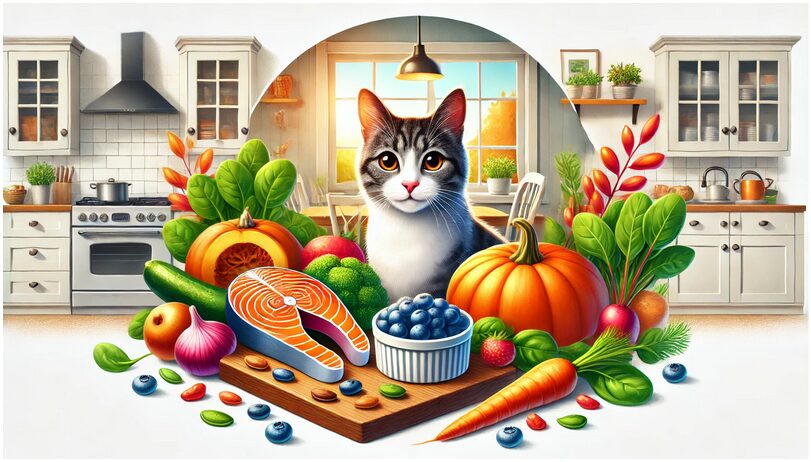As cat owners, we all want our furry companions to lead long, happy, and healthy lives. While commercial cat food is typically formulated to meet their nutritional needs, adding certain safe human foods to their diet can provide additional health benefits. These so-called “cat superfoods” are packed with nutrients that support overall well-being. However, it’s crucial to know which foods are safe and how to serve them to avoid any potential risks.
Let’s dive into some of the top healthy cat foods that double as safe human food for cats, along with tips on serving sizes and precautions to keep in mind.
1. Salmon
Salmon is a fantastic source of omega-3 fatty acids, which promote a shiny coat, reduce inflammation, and support brain and heart health.
How to Serve:
- Cooked, plain salmon (without seasoning, garlic, or onions) is best for cats.
- Offer a small portion—about a teaspoon or two—as an occasional treat.
Precautions:
- Avoid raw salmon due to the risk of parasites and bacteria.
- Remove any bones before serving.
2. Pumpkin
Pumpkin is a fiber-rich food that aids digestion, helps with hairball control, and can ease both constipation and diarrhea.
How to Serve:
- Use plain, cooked pumpkin or canned pumpkin (not the spiced variety used for pies).
- Serve 1 teaspoon mixed into their regular food.
Precautions:
- Avoid feeding pumpkin seeds unless they’re cooked and ground into a fine powder.
3. Blueberries
Blueberries are antioxidant powerhouses that support immune health and may help combat oxidative stress.
How to Serve:
- Offer one or two fresh or frozen blueberries as a treat.
- You can mash them slightly to make them easier for your cat to eat.
Precautions:
- Always wash thoroughly to remove pesticides or contaminants.
4. Chicken
Lean, cooked chicken is an excellent source of protein, vital for maintaining muscle health and energy levels.
How to Serve:
- Serve plain, boiled, or baked chicken without seasoning.
- Cut into small, bite-sized pieces.
Precautions:
- Remove all bones and skin to avoid choking hazards or excess fat.
5. Eggs
Eggs are packed with protein, amino acids, and essential vitamins like B12 and D.
How to Serve:
- Serve cooked eggs (boiled or scrambled) in small amounts.
- One teaspoon is enough for most cats.
Precautions:
- Never feed raw eggs due to the risk of salmonella.
- Avoid adding salt, butter, or oil.
6. Carrots
Carrots are rich in beta-carotene, which supports eye health and the immune system.
How to Serve:
- Cook and mash or finely chop carrots for easier digestion.
- Serve a teaspoon-sized portion occasionally.
Precautions:
- Avoid raw carrots, as they can be a choking hazard.
7. Spinach
Spinach is loaded with vitamins A, C, and K, as well as iron and calcium. It’s great for overall health when fed in moderation.
How to Serve:
- Steam spinach leaves and chop them into small pieces.
- Offer a teaspoon mixed into your cat’s food.
Precautions:
- Avoid spinach if your cat has a history of urinary or kidney issues, as it contains oxalates that can contribute to stone formation.
8. Apples
Apples are a good source of vitamins A and C, which support skin and immune health.
How to Serve:
- Peel and remove the seeds and core before slicing into small, manageable pieces.
- Serve a tiny slice or two occasionally.
Precautions:
- Apple seeds contain cyanide and are toxic to cats.
9. Plain Yogurt
Plain, unsweetened yogurt can be a great source of probiotics, which support gut health.
How to Serve:
- Offer a small lick or half a teaspoon as a treat.
Precautions:
- Ensure the yogurt contains no artificial sweeteners like xylitol, which is toxic to cats.
General Guidelines for Feeding Human Food to Cats
- Moderation is Key: Human foods should be given as occasional treats and not replace a balanced cat diet.
- Introduce Slowly: When introducing a new food, start with a small amount to monitor for any adverse reactions.
- Avoid Toxic Foods: Never feed cats chocolate, grapes, raisins, onions, garlic, or anything seasoned with these ingredients.
- Consult Your Vet: Always consult your veterinarian before adding new foods to your cat’s diet, especially if they have existing health issues.
Final Thoughts
Incorporating safe, healthy cat foods into your feline’s diet can be a fun way to enhance their nutrition. By sticking to the superfoods listed above and following the serving guidelines, you can feel confident that you’re giving your cat something both delicious and beneficial. Always prioritize safety and consult your vet when in doubt.
Want to learn more about keeping your cat healthy and happy? Explore our other posts on feline nutrition and care!






